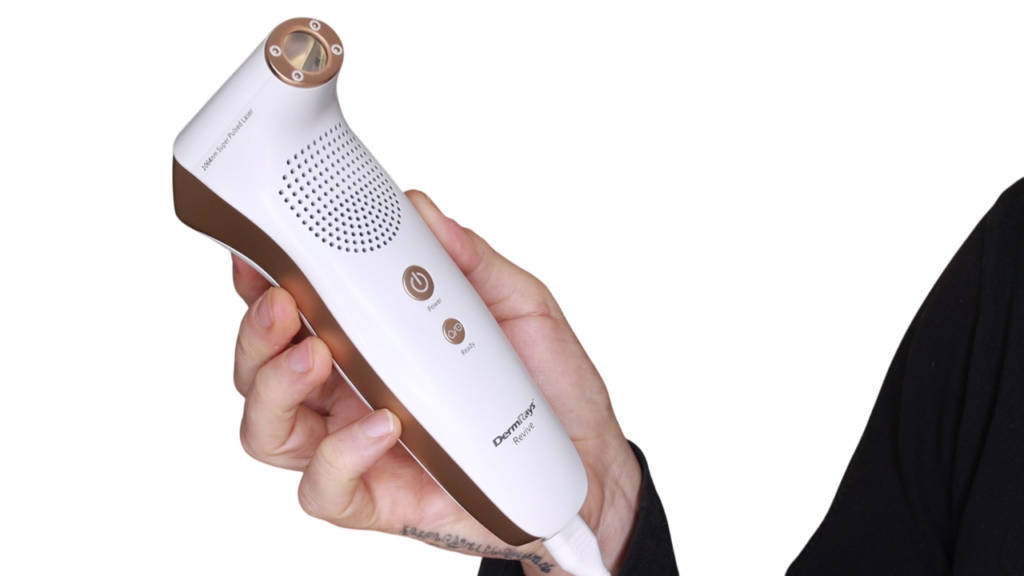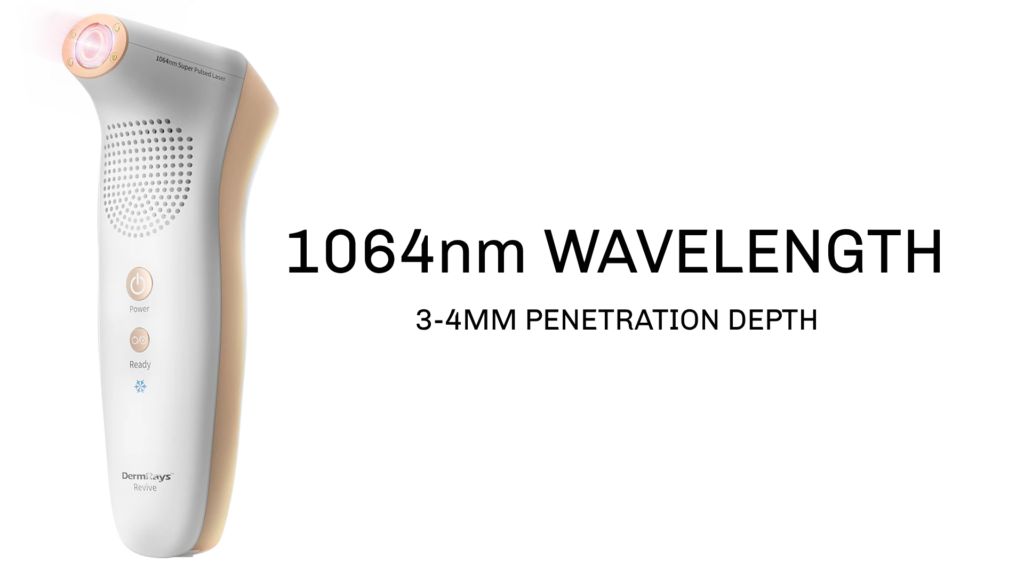If you’ve ever gone down the rabbit hole of at-home laser devices, you know how overwhelming it can be. Bold claims, slick marketing, and a flood of gadgets promising everything from wrinkle reduction to skin tightening—yet so many fall short. When the Dermrays Revive and Nira Pro+ both landed on my beauty cabinet, I decided it was time for a true, side-by-side test. The results? Eye-opening, to say the least.
I’m TJ, a 43-year-old beauty therapist and trainee aesthetician. I like to know exactly what’s happening beneath my skin before I commit to any device. Over the past month, I put both devices to the test—one on each side of my face—following the protocols to the letter. Here’s what I found, from the science and specs to the real-world results.
Introducing the Dermrays Revive
Let’s start with the Dermrays Revive. This isn’t your average at-home gadget. It’s a clinical-grade, FDA-cleared diode laser using a 1064nm wavelength—a detail that matters because 1064nm penetrates deep into the skin, reaching the reticular dermis (about 3–4mm deep), where your skin’s true support structure lives.
The Revive delivers an energy density of 10 joules per square centimetre—about four times more powerful than the original Nira and over twice as powerful as the Nira Pro+. But it’s not just about power. The Revive offers variable pulse widths (200, 300, and 400 milliseconds) and a total energy output of 17.7 joules per pulse, enabling it to remodel the collagen framework, not just smooth the surface.
A standout feature is its built-in cooling system, which keeps the skin surface at a comfortable 15–18°C, even as the dermis underneath is heated to the collagen-stimulating sweet spot of around 43°C. This means you get professional-grade results without the discomfort you might expect from such a powerful device.
The Revive isn’t just about collagen. Its 1064nm wavelength targets water, melanin, and hemoglobin, helping with pigmentation, redness, and even pore size. It’s a true multitasker, with a treatment schedule that’s manageable: 3–4 times a week for two weeks, then 2–3 times a week for three weeks, and after that, just once a month for maintenance.

How Does the Nira Pro+ Compare?
The Nira Pro+ uses a 1450nm laser—a more superficial wavelength that penetrates only about half a millimetre deep, focusing on the papillary dermis. This makes it ideal for fine lines, surface texture, and giving your skin that polished, fresh look.
Energy density is another key difference. The Revive delivers 10 J/cm², while the Nira Pro+ ranges between 2.1 and 3.8 J/cm². The lower energy is perfect for the upper dermis, where you don’t want to overdo it.
Both devices are non-ablative and non-fractionated, meaning they heat the dermis without damaging the surface—unlike your average LED mask, these are in a different league entirely.
Comfort-wise, the Revive’s cooling system keeps the skin surface cool, making longer sessions comfortable, even for sensitive skin. The Nira can feel a bit hot, especially around the eyes, but it’s quick and easy for targeted areas.
Design-wise, the Revive’s latest version has just two contact points, making it easier to use on curved areas like the forehead. The Nira’s smaller head is great for precision, especially around the eyes.
Protocols and Ease of Use
Dermrays Revive: 3–4 times a week for two weeks, then 2–3 times a week for three weeks, then once a month for maintenance. Each session takes about 5–7 minutes per half-face.
Nira Pro+: Daily for the first 90 days, then twice a week. Each session is about two minutes, focused on fine lines and the eye area.
With the Revive, you simply cleanse your skin, pat dry, place the device flat against your skin until you hear the beep, then move in small sections, overlapping slightly. The Nira Pro+ is similarly straightforward, but its smaller head makes it ideal for precision work.
Not Competitors—Compliments
Here’s where many people get it wrong: these devices aren’t direct competitors. They’re more like different tools for different jobs.
Nira Pro+: Think of it as a detailer for the upper layers. Perfect for fine lines, surface texture, and especially the delicate eye area. Gentle, precise, and great for daily maintenance.
Dermrays Revive: This is your structural engineer. It goes deeper, targeting the reticular dermis to rebuild the collagen framework—ideal for sagging, loss of contour, and more significant signs of aging.
You wouldn’t use a sledgehammer to hang a picture, just like you wouldn’t use a tack hammer to break up concrete. Each tool has its place, and both can work together in a routine.
The Science: What’s Happening in the Reticular Dermis?
The reticular dermis is the thick, lower part of your dermis, packed with dense collagen and elastin fibers—the scaffolding that keeps your skin firm and lifted. As we age, this collagen breaks down, leading to sagging and deeper wrinkles.
The 1064nm wavelength of the Revive bypasses the upper layers and delivers energy right where it’s needed, without damaging the surface. It heats the tissue to about 43°C, triggering “selective photothermolysis”—controlled heat that stimulates fibroblasts (the cells that make collagen and elastin).
You get an immediate tightening effect from collagen contraction, and over the next few weeks, your skin starts building new, better-organized collagen. The 1064nm wavelength also targets water, melanin, and hemoglobin, offering bonus effects like:
Whitening: Fades pigmentation by targeting deeper melanin.
Redness reduction: Seals off tiny blood vessels, helping with redness and broken capillaries.
Pore minimization: Suppresses sebaceous gland activity, shrinking pores.
30-Day Split-Face Results
For the past month, I’ve used the Revive on one side of my face and the Nira Pro+ on the other. Here’s what happened:
Revive side: Firmer jawline and cheek, improved pigmentation, and better overall tone. The cooling system made sessions comfortable, even on sensitive spots.
Nira side: Smoother, finer lines, especially around the eyes, and a nice surface glow.
No irritation from either device, but the Revive’s cooling system definitely made longer sessions more pleasant.
Who Should Choose the Dermrays Revive?
The Revive is best for those dealing with moderate signs of aging—sagging, deeper wrinkles, or loss of contour. Its deeper reach targets structural changes that superficial treatments can’t touch. It’s also a multitasker, addressing firmness, pigmentation, redness, and pores all at once.
If you’re not a fan of daily treatments, you’ll appreciate the less demanding schedule after the first month. Sensitive skin? The 1064nm wavelength and cooling system make it gentle enough for most people.
Price Comparison: At-Home vs. In-Clinic
Nira Pro+: $649 (often discounted to $580)
Dermrays Revive: $699 (often discounted to $579)
In-clinic laser sessions can run $300–$500 per visit, with most people needing three to six sessions for results. That’s $1,000–$3,000 for an initial course, not including maintenance. Radiofrequency treatments are similar or higher.
With both the Revive and Nira Pro+, you’re making a one-time investment for unlimited use at home. Break it down over a year, and you’re looking at less than $2 a day—less than your daily coffee. Both devices come with warranties, and Nira offers a 90-day money-back guarantee.

Final Thoughts: Which Device Is Right for You?
More power doesn’t always mean better results—it’s about using the right tool for the right job. The Revive isn’t “better” than the Nira Pro+ just because it’s more powerful; it’s designed for a different layer of the skin.
Want to rebuild your skin’s structure and tackle moderate aging? Go for the Revive.
Want to polish the surface and target fine lines, especially around the eyes? The Nira Pro+ is hard to beat.
Personally, I love that the Revive means fewer sessions over time, and its depth allows me to cut back on professional RF treatments. For the eye area, the Nira Pro+ is easier to use, but the Revive is great for slight hooding and overall firmness.
Both are comfortable, both deliver results, and both are a significant step up from typical at-home devices. If you’re serious about your skin, you may find a place for both in your routine.
Have questions? Drop them below. Here’s to smarter, more effective at-home skincare!
